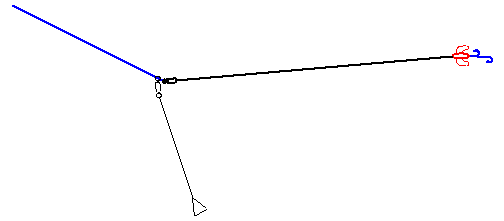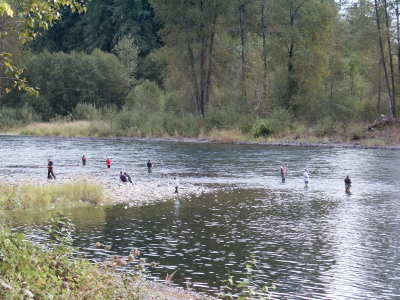Techniques for Bank Fishing Salmon
/ Steelhead on Coastal Rivers
There can be many different techniques for catching salmon from the banks
of rivers, but the three primary techniques with are variations, are basically plunking,
casting and flipping.
Plunking
: Plunking is a term mainly used for
casting out into the river & letting a sinker hold your offering near the
bottom, hopefully in a migration path of upstream swimming fish. The
main choice of bait would be cured salmon eggs.
Depending on where you fish & the regulations, you can either fish one,
two or even three rigs. One method used by many is to use a Spin-N-Glo
as an attractant in a size from size 2 to 0. Thread a Spin-N-Glo on the bottom leader about
30", tie an egg snelled tie on the hook.
This will be your bottom leader to the bait. You can then either use
just the Spin-N-Glo alone or with eggs. Preferred colors for
the Spin-N-Glos seem to be chartreuse & or orange.
| Typical
Plunking set-up |
 |
You can attach this leader to either a 2 or a 3 way swivel, depending on
your preference as to how to attach the sinker. If you want the sinker as a slider use the 2 way & put the
slider on the line above the swivel. Some fishermen prefer to use a
sturgeon slider instead of the 2 way swivel. If however you want to run the sinker on a
dropper, then use the 3 way. Droppers
should be 8-12”, & of a lighter leader material.
If you are to use a double rig then go up the line about 36” & put in
another 3 way swivel, which you will attach another leader rig of about 24”,
crimp a plastic sleeve or drinking straw about 1 ½ - 2" long on the side eye (this shorter
leader & plastic, helps to keep it from tangling in the lower rig).
Depending on the fish you are targeting, the hook sizes can vary from a 1/0
to a 4/0 +.
You probably should make up complete
spare leader setups, as usually it is easier to tie these up at home than on the
river with wet or cold hands. This takes away from valuable fishing time
also.
This method tends to work best in pools with slower moving water, where
the fish tend to congregate, after going thru fast moving water & as a
resting place before heading on upriver. Now here is where you normally do
not need to cast clear across the river, as the
fish tend to follow the shore more than you think. You will find that fish seem to be
the most aggressive after just entering a pool. Chinook
salmon will come up and mouth a plain Spin-N-Glo, so you have to be ever watchful of the rod tip.
Coho on the other hand will whach it.
Most plunkers use a rod holder set into the river bank in a metal rod
holder, or even a section of PVC attached to a 1.2" metal rod that is
sharpened on the lower end. I have found that when you make up one
of these, you may not be able to find a sandy bar, but it could be a gravel bar
instead. Here you may want to weld a cross bar onto the
upright to give you some sort of push part with your foot. Otherwise you
may have to bring along a large hammer or find a big rock to drive it into the
gravel with. You should also consider getting a little bell to attach to your rod tip as a
signaling device, as many times you may get complacent & not be attentively
watching the rod tip 100% of the time.
The Spin-N-Glo does a multitude of things.
It is buoyant & helps hold the bait up off the bottom. It has a bright color, which can help
attract the fish. But most important it
has the rotating spinner blades, that
give off a vibration, which the fish can feel, thereby attracting them to a
possible wounded baitfish.
Then there is the question of scent.
Do I use it or not? Well, salmon
& steelhead have a very good sense of smell. In my mind it sure does not hurt to add some egg scent, maybe on
a freshly cast out egg roe, there is enough scent, but after it has soaked for a
while you have lost part of your attractant.
If you are new to the game, then the easiest way to learn is to watch others around you.
You don't have to be a rocket scientist, just watch others if they are
near & make mental notes as to what they are using & how they are using
it.
Casting
: In casting you have the choice of a multitude of lures, spoons, spinners,
plugs, or roe. Each will have it’s own
retrieve speed. Depending on the water
flow, depth, & fish targeted the methods will vary to some degree. You will have to decide whether you want to
fish the hole, run or the tail-out of the pools. Cast out to your targeted spot & then reel it back. You will have to experiment as to whether
you start reeling immediately or wait until the lure has sunk to a desire
depth. Also you will have to determine
just how fast you reel back in.
Remember that all reels are not using the same gear ratios, so if one
reel retrieves at a proper speed, another may be faster or slower.
Cast closest to you first, progressively moving away each time. This
allows you to not spook a nearby fish by casting over them.
| Casters
working a run above a hole |
 |
The thing about this type of fishing is that when the fish hit the lure,
they hit it hard enough that you are fully aware of what is going on.
Casting will probably be best accomplished by a spinning outfit with a rod
of 8’ 6" or 9’ plus. Here is one area that the rod & reel
should be matched as you will be flailing it quite a bit.
A variation of casting would be Bobber fishing. Here you use a bobber that holds you lure,
(eggs, jig, etc.) just up off the bottom.
You may have to adjust the bobber height from the bait, until you find
the right depth of the water for the particular drift you are doing. You can cast a little farther with this type of fishing than the flipping &
allow your line to pay out on the lower end of your drift, to cover slightly
more water if conditions exist. On this type of fishing you want the line to
the bobber as straight a possible, so you may have to “meld” your line to take
the slack out of the line & keep the side or current pull off.
Flipping
: This is a term many
fisherpersons may not be familiar with. It can be more productive
than the methods as
long as there is sufficient current to allow a good drift. This method is a valuable technique to learn
because it works on any stream that holds salmon or steelhead.
One of the most effective set ups to use is a glass bead on top of a 1/0 to 3/0
hook with a piece of chartreuse yarn on
the egg loop of the hook. This simple rig has a proven track record for
taking more salmon of all
species than probably any other setup when used by knowledable fisherpersons.
Another variation used for Chinook salmon is to rig using two single hooks.
Once again in size 1/0 to 3/0 tie an egg snell with two octopus
style hooks about 2 to 3 inches apart. In between the two hooks place two of the smallest size little
corkies with florescent chartreuse, orange or red being the favorite colors.
Once again, always use a piece
of florescent chartreuse yarn.
Some fishermen may even use coho flies for this technique.
The above setup is then attached using about 4 to 6 inches of a lighter
leader running up to a sinker. This then acts as a breakaway if you get hung
up. Also some fishermen prefer the surgical rubber tube lead on a
three-way swivel. The longest leader you can handle seems to result in more
hook ups. But you need to be able to control the flip.
The technique is a little more complicated then just throwing the hook
upstream and letting it bounce downstream. You don’t use the reel at all when
using this technique. For a right
handed person, hold the rod in your right hand. Strip off enough line so the
lure doesn’t hit the ground when you hold the rod pointing straight up with
your right hand. Now with the left hand strip off more line so when you extend
your left arm while holding onto the line, you can still hold the lure off the ground. Now just flip the lure out, lower the rod
tip and let go of the line. The lure should flick about 15 to 20 feet in front
of you depending on your rod length. You don’t need to cast very far at all.
Usually a 45 degree cast upstream is a good starting point. Salmon run up river along the edges for the
most part. 10 to 20 feet from shore is usually plenty far.
Casting upstream a little bit, starting at about 45 degrees, varying it as
you go, you need enough weight that you can feel the weight bouncing along the
bottom. As soon as the lure hits the water lower your rod tip to just above the
water level by a foot or two. Not too
much that it will hang up though. NOW THIS IS THE IMPORTANT PART!! As the line swings in front of you, you want
to slowly sweep the rod with the current, keeping the tip pointed low &
toward your line entry point on the water. At the same time, with your left
hand grasp the line at the rear guide, and as you allow the rod to follow the
current, slowly pull the line in to take the slack out of your line to the
lure, so you will have constant tension on the line. You may have to reach up with your left hand & get another
grip on the line & pull it in as before.
When you get to the bottom of the drift & you are about ready to
pull it out, you might want to give it a slight jerk toward the bank. This jerk will at times set the hook if the fish has just picked
up the line on the last of the drift, and has it running thru his open mouth,
but has not actually hit the lure. This
is the method of catching sockeye in Alaska, in or near his mouth.
The idea is to keep the line all the way to the lure as perpendicular as
possible to the bank. This insures that when a fish hits, instead of momentary
slack as the lead bounces past the fish and then you feel the bite, you feel
the fish immediately. Imagine if you cast your lure and weight upstream and let
it dead drift down without any "pull." The lure would be pulled
downstream below the sinker as the sinker kept on grabbing the bottom.
If a fish
hits the lure, you wouldn’t know it until the sinker bounced 4 feet down to the
fish, then four feet past the fish until the line tightened up. By then the
fish will be long gone! KEEP LIGHT BUT CONSTANT TENSION ON THE LINE BY DRAGGING
THE LURE SLOWLY TOWARDS THE BANK. Keeping a constant "pull" on the line is the key element in
the flipping technique. As soon as you feel something different from the bottom
you have bounced by for hours, set the hook!
Better to look foolish, than to lose the fish you have been waiting all
day for. Most of the time though, the
fish will tear your arm off because you only have 15 feet of line out…if you
keep some tension on the line.
You can vary where your drift is in footage from the bank by varying your spot
you are casting to. It is advisable to
cast closer to shore on the first casts, & move your casts farther out on
your next casts. By using this method
you will not be fishing OVER the closer fish & spook them. You will in this
manner cover all the water starting from closer to farther out from one
location.
It will prove very beneficial for you to use premium ultra sharp hooks like the
Gamakatsu, VMC,
or Owner type hooks. Your hook up ratio will at least double by the use of
ultra sharp premium hooks. They also punch a very small slit through the fish’s
mouth that helps keep the hook from backing out. This technique can be used in
about any river where the water is flowing at a fairly decent pace. It also it
the exact same technique used to catch sockeye when they start running up the
Kenai & Russian Rivers in Alaska. It also has proven effective for silvers and pinks as
well.
Any type of rod can be used for flipping. The light well balanced rod allows you to fish much longer than
a traditional heavy outfit with a spinning or baitcasting reel. The longer the
rod, the more water you can cover effortlessly. Of course in crowded conditions
a shorter rod is way more practical.
In the lower states, versions of this method has been called
"Flossing" & you will could get into great debates as to whether
it is legal & / or ethical. The riotous say anytime the fish
does not voluntarily take a lure in the mouth, it is snagging. They also
say that if you use a long leader that you are flossing. How long is
long? In my estimation, there IS a difference between flossing &
snagging. I have taken many salmon by this method with them taking the
lure in the mouth.
Some final pieces of advice…
Use the best gear you can afford.
Make sure the drags on the reels are good because these fish may well
test your gear to the limit. When adjusting the drag, don’t just pull on the
line above the spool.
Also always re-spool with fresh line every year, or at least swap ends. Its amazing how strong
fresh line is. You could land a 20 pound Chinook on 10 pound test, maybe not
easily, but it can be done. As an
example, take your rod and tie the line to a hand scale. Pull on the rod so you
have a good bend. You’ll be surprised how hard 5 to 10 pounds of pull will bend
your rod if it doesn’t break it first. The main reason for fresh line is that
line gets weaker when it is stored, exposed to sunlight and coiled tightly on
the spool. It is the only thing connecting you and the fish.
Also abrasions on
a 20 pound line will quickly turn the line into a 5 lb rating! Every time you go out cut
off 4 to 5’ of line & retie, then
check it after every fish. Line is cheap in comparison to lost
fish. Also keep your hooks sharp. Check the point on your thumbnail,
if it slides off, it is DULL, sharpen it until it digs in with the slightest
contact.
Also learn to tie good knots. Some of the PSA chapters have made
"knot busters", these are simply a recording fish scale that is
set in a frame with a small rubber covered spool that has a hand crank attached
to it. The procedure here is to tie your favorite knot to hook or swivel
eye to a section of line, then wrap it onto the spool, overlapping to bind it
up. Keep winding the spool until something breaks. This will make a
believer out of you.
Originated 10-10-00, Last Updated 01-06-2006
LeeRoy Wisner
For a link to great information by
Rudy Tsukada go to
http://www.alaskafishinglogs.com/rudystip.htm



